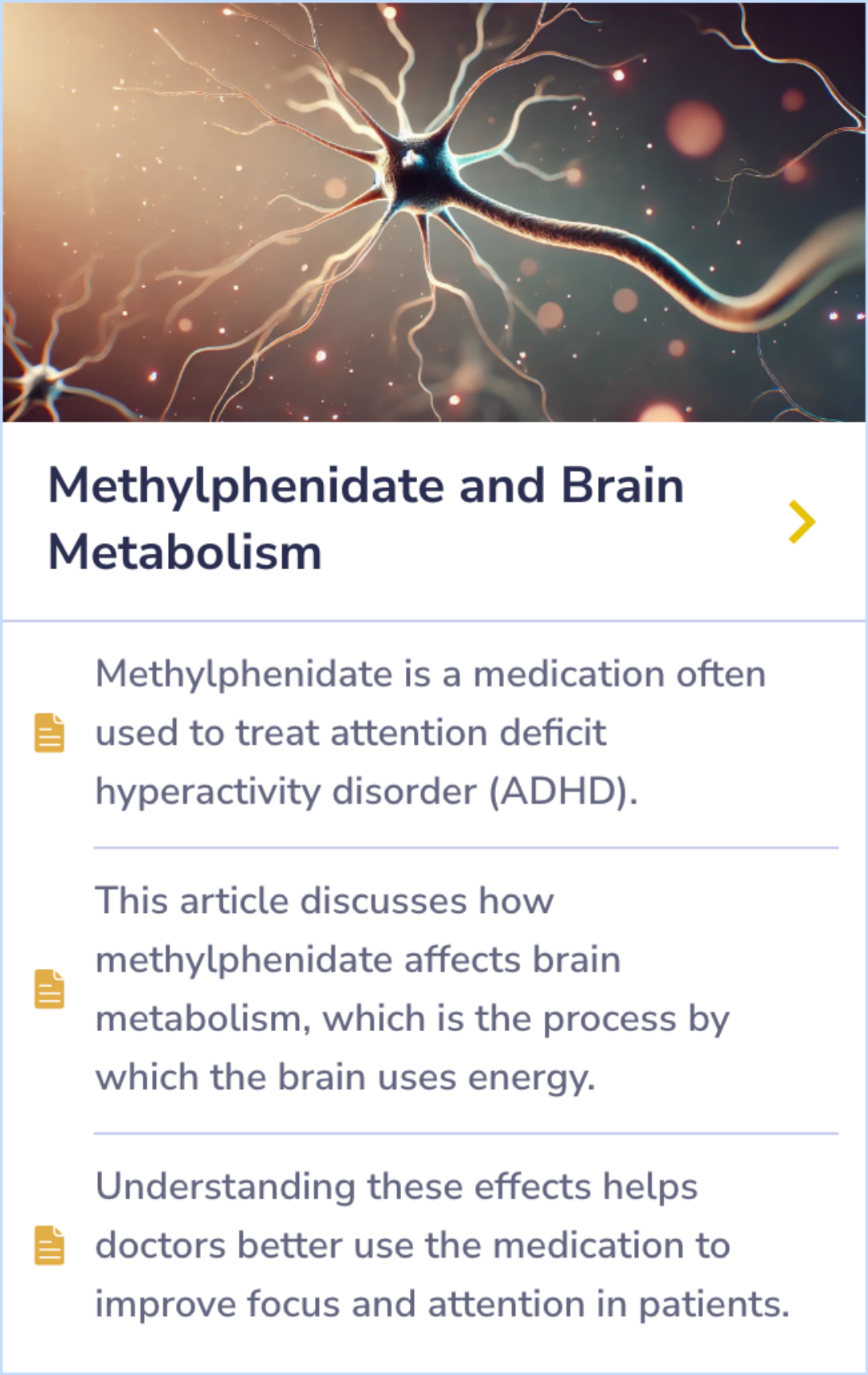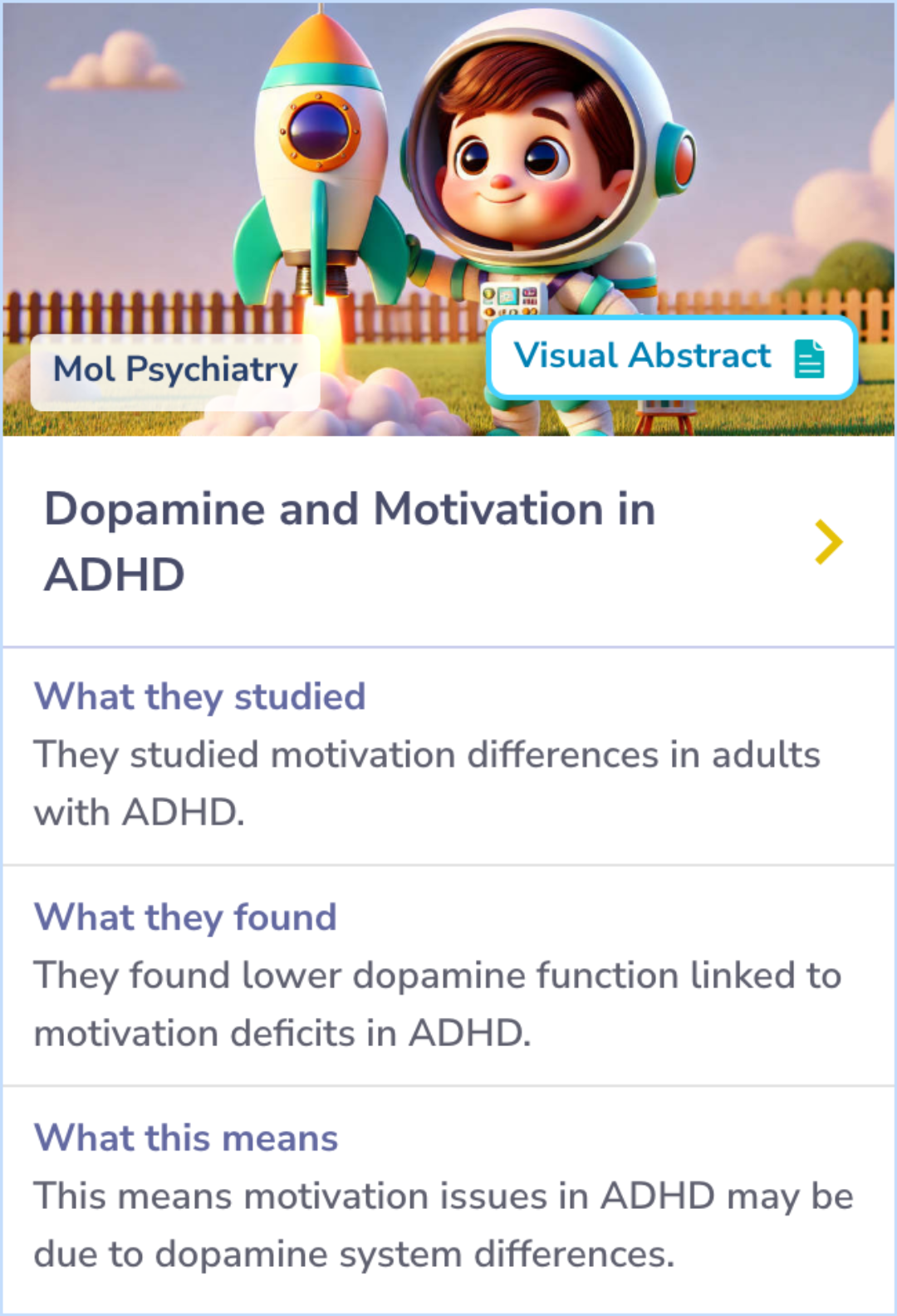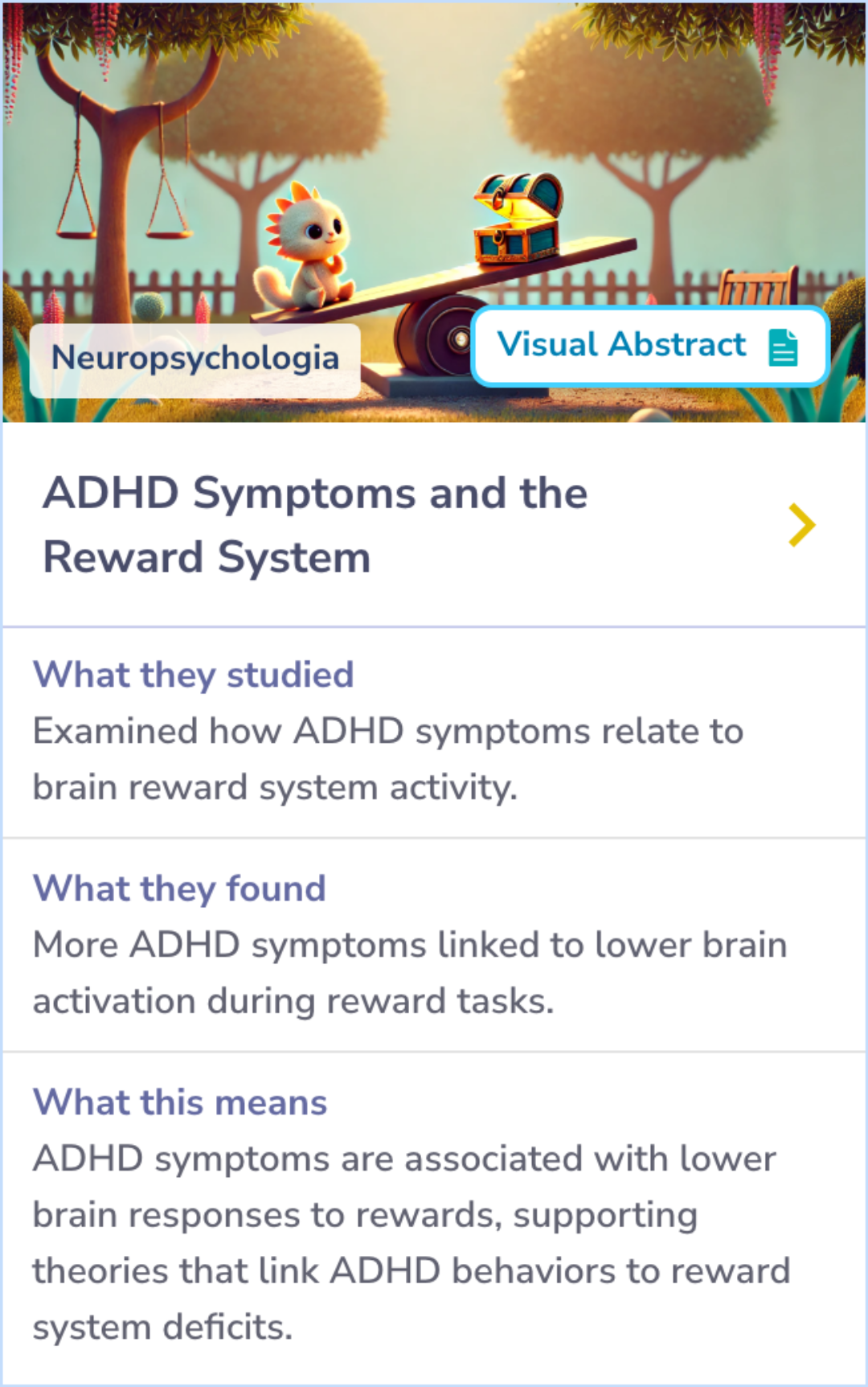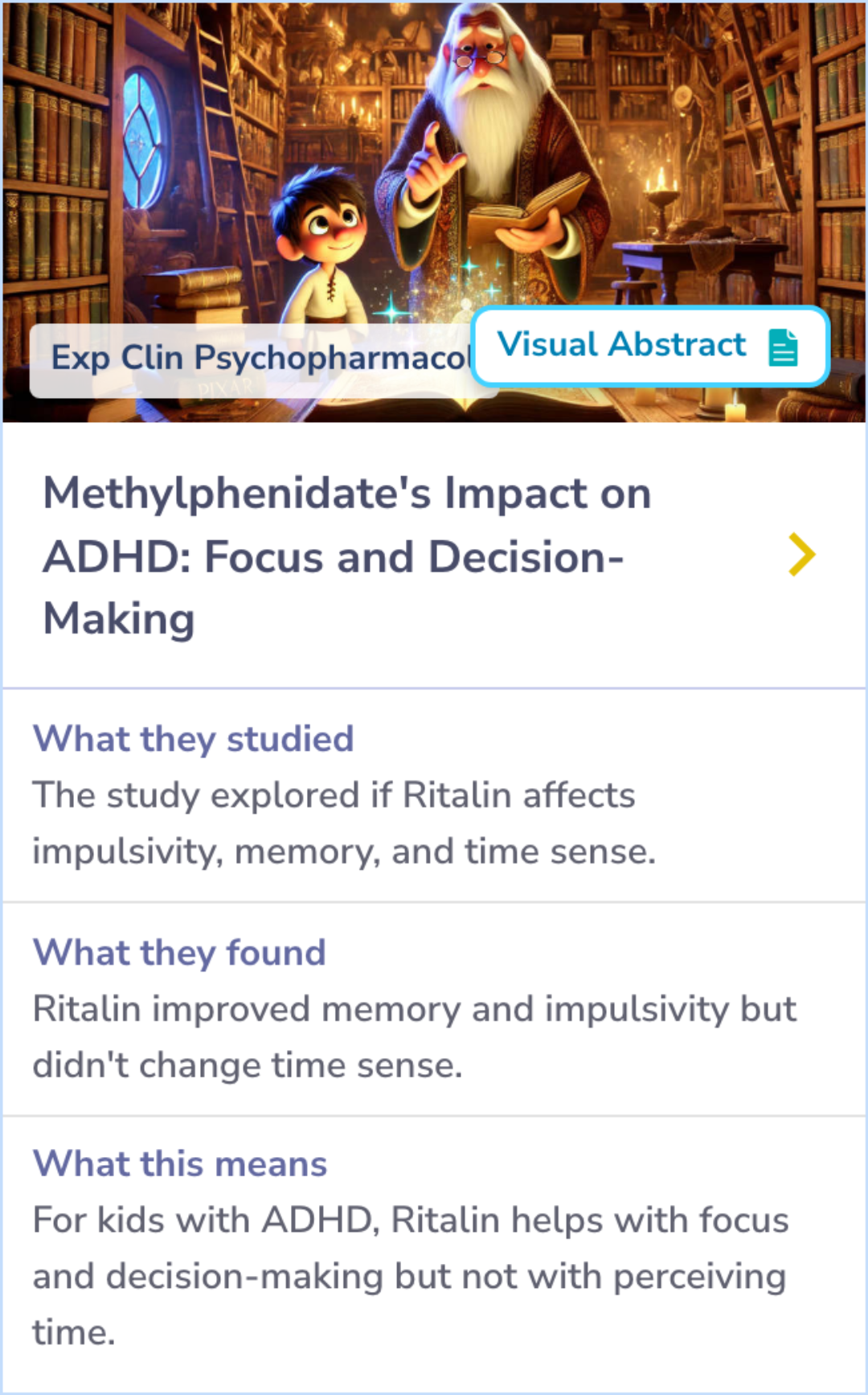Ritalin
Evidence Based Answers
Insights into Ritalin (methylphenidate) from Neuroimaging and fMRI
Neuroimaging reveals Ritalin increases dopamine, boosts focus, and may protect brain cells, offering insights into its effects beyond ADHD treatment.
Published: October 25, 2024
Click to explore a section:
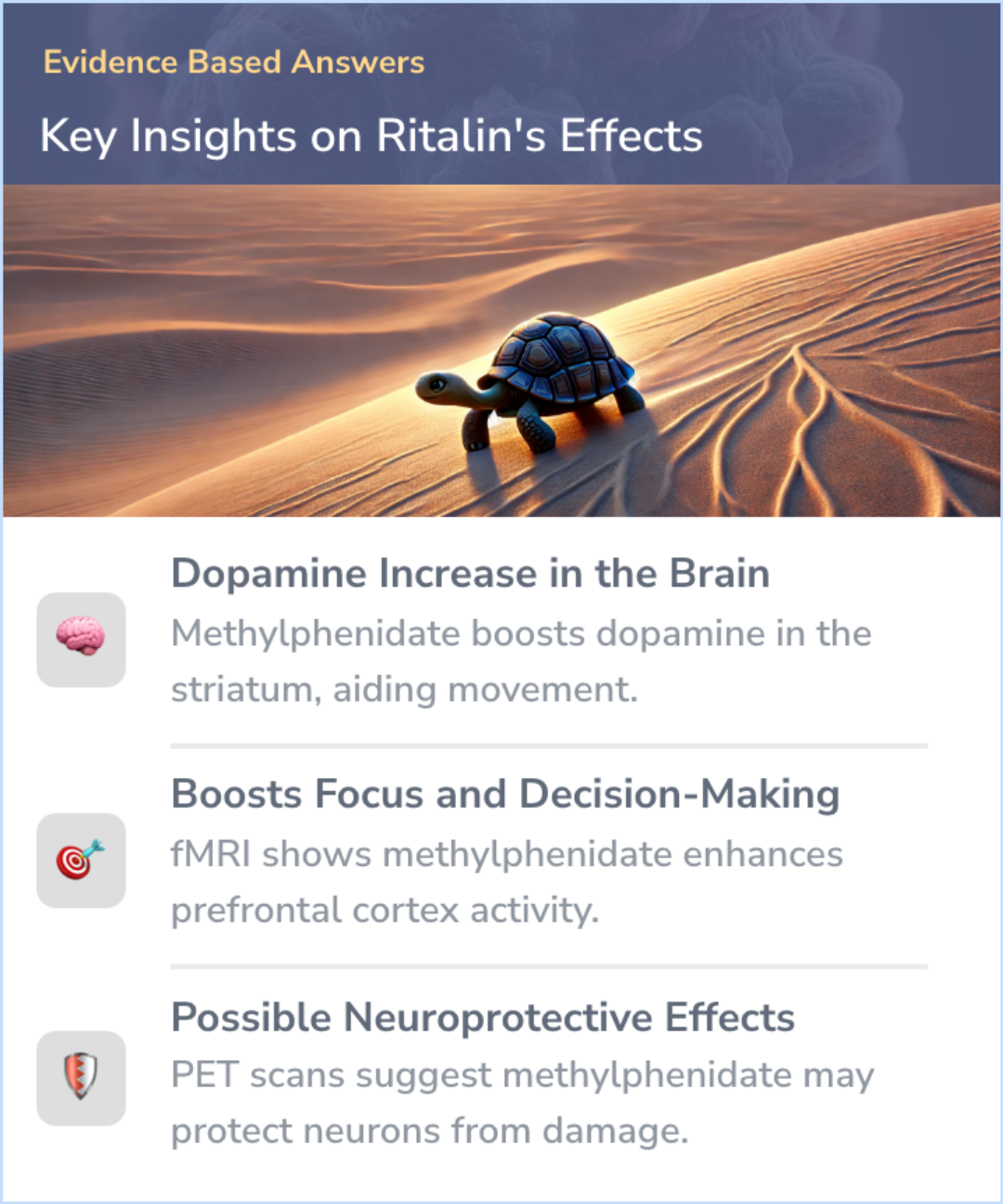
Neuroimaging shows Ritalin boosts dopamine, enhances focus, and may protect neurons.
Studies Summary
🧠
Methylphenidate Boosts Dopamine in the Brain
Neuroimaging studies, especially PET scans, show that methylphenidate increases dopamine levels in the striatum, a brain area involved in movement and reward. This increase helps explain the drug's stimulant effects and its effectiveness in treating ADHD.
⚡
Methylphenidate Enhances Brain Activity in Key Areas
fMRI studies reveal that methylphenidate boosts activity in the prefrontal cortex, a brain region important for attention and decision-making. This improved brain activity helps people with ADHD focus better and manage impulses.
🧠
Comparing Brain Activity with and without Ritalin
Studies using fMRI compare brain activity in individuals with ADHD before and after taking Ritalin. Results show that untreated ADHD brains have reduced activity in key areas like the prefrontal cortex. After taking Ritalin, these areas show increased activity, closer to levels seen in individuals without ADHD. This suggests that Ritalin helps correct underactivity in the brain's attention and control networks.
How Methylphenidate Affects Dopamine Levels in the Brain
Neuroimaging studies, particularly PET scans, have been important in showing how methylphenidate, commonly known as Ritalin, influences dopamine levels in the brain. These studies reveal that methylphenidate primarily increases dopamine concentration in the striatum, a region that helps regulate movement and reward.
This increased dopamine activity, seen through neuroimaging, explains the drug's stimulant effects and its benefits in treating ADHD.
This increased dopamine activity, seen through neuroimaging, explains the drug's stimulant effects and its benefits in treating ADHD.
“
Source Quotes:
A positron emission tomography (PET) study in humans showed that 7.5% (+- 1.5%) of [11C]-MPH molecules (administered intravenously) enter the brain, with the highest concentration detected in the striatum, and significantly lower in the cortex and cerebellum.
The more recent application of single-photon emission computed tomography has helped to confirm that the highest area of methylphenidate uptake in humans is in the striatum.
How fMRI Reveals Methylphenidate’s Effect on Brain Activity
Functional MRI (fMRI) studies show that methylphenidate affects brain activity by enhancing activity in the prefrontal cortex, a region involved in attention and decision-making. By improving the signal-to-noise ratio in brain cell firing, methylphenidate helps individuals with ADHD focus better and control impulses.
fMRI helps visualize these changes in real-time, offering insights into how the drug works at a functional level.
fMRI helps visualize these changes in real-time, offering insights into how the drug works at a functional level.
“
Source Quotes:
Stimulant-induced dopamine increases in the striatum are believed to decrease background firing rates and increase signal-to-noise ratio of striatal cells, which we postulate as a mechanism for improving attention by enhancement of task-related neuronal cell firing.
Methylphenidate blocks the reuptake of two neurotransmitters, norepinephrine (NE) and dopamine, in presynaptic neurons.
Neuroimaging Highlights Potential Neuroprotective Benefits of Methylphenidate
Beyond treating ADHD, neuroimaging studies suggest that methylphenidate may also offer neuroprotective benefits. PET studies indicate that by increasing dopamine levels, methylphenidate could help protect neurons in conditions like Parkinson’s disease.
These findings point to potential new uses for methylphenidate, with neuroimaging playing a key role in understanding these benefits.
These findings point to potential new uses for methylphenidate, with neuroimaging playing a key role in understanding these benefits.
“
Source Quotes:
Methylphenidate can provide neuroprotection in certain conditions like Parkinson disease, which involves loss of dopaminergic neurons.
This effect occurs not only through its direct inhibition of the dopamine transporter but also via indirect regulation of the vesicular monoamine transporter 2.
Key Takeaways
Conclusions
Neuroimaging and fMRI studies highlight how Ritalin (methylphenidate) profoundly influences brain function. PET scans reveal its ability to increase dopamine levels in the striatum, explaining its role in managing ADHD symptoms.
fMRI further shows that Ritalin enhances activity in the prefrontal cortex, aiding attention and impulse control. These insights extend to potential neuroprotective benefits, suggesting broader applications beyond ADHD treatment.
fMRI further shows that Ritalin enhances activity in the prefrontal cortex, aiding attention and impulse control. These insights extend to potential neuroprotective benefits, suggesting broader applications beyond ADHD treatment.
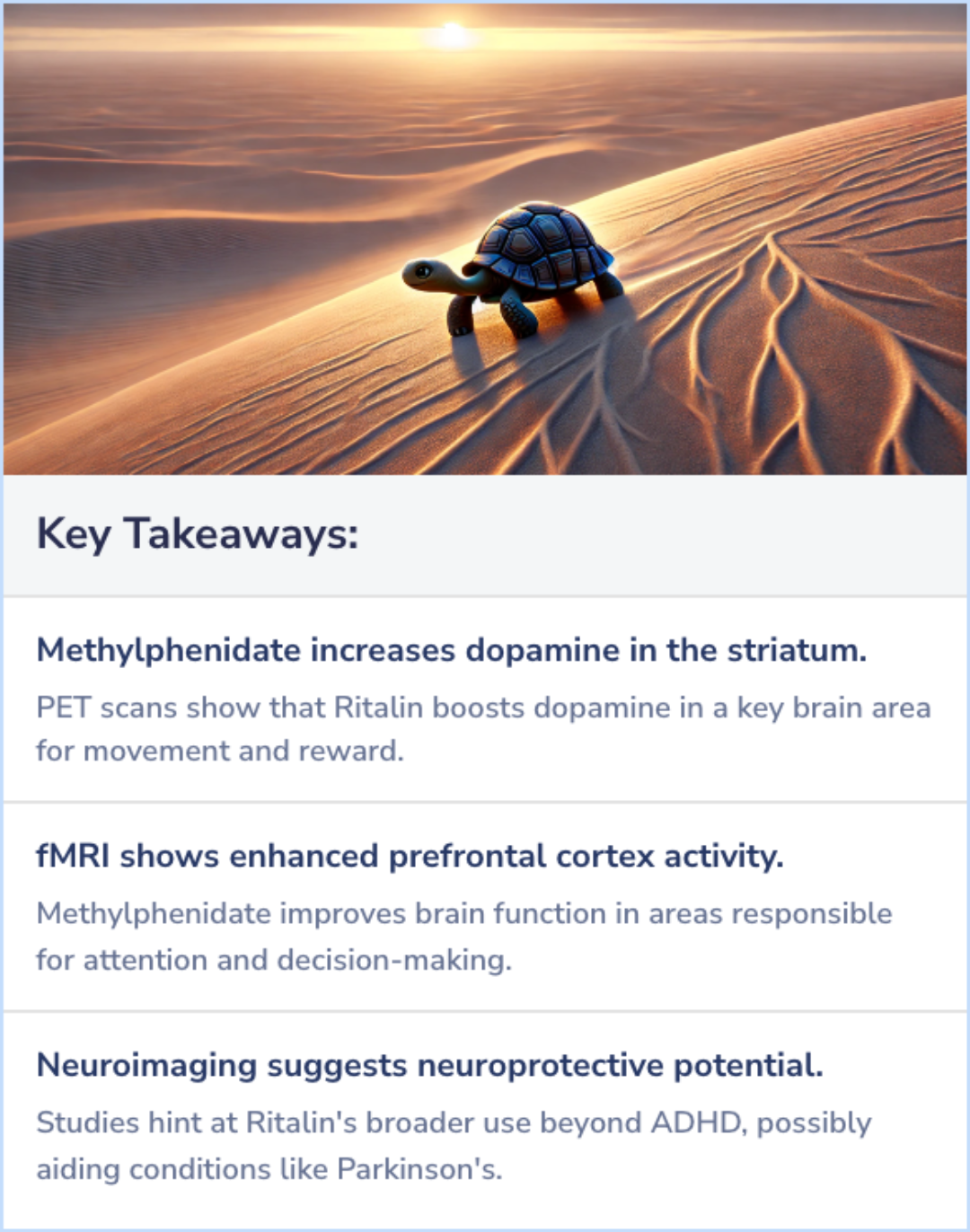
Evidence Summary
How Ritalin Alters Brain Metabolism
Methylphenidate, commonly known as Ritalin, affects how the brain uses energy, which helps doctors optimize treatment for ADHD. It boosts brain metabolism, aiding focus and attention.
Ritalin is frequently prescribed for ADHD. It works by altering brain metabolism, the process of energy use, improving focus and attention in patients.
Ritalin is frequently prescribed for ADHD. It works by altering brain metabolism, the process of energy use, improving focus and attention in patients.
Evidence Summary
Dopamine's Role in ADHD Motivation Deficits
Adults with ADHD show decreased function in the brain's dopamine reward pathway, which could explain their motivation deficits. Using PET scans, researchers found lower availability of dopamine receptors and transporters in key brain areas. This reduced dopamine function correlated with lower scores on a motivation scale and higher inattention symptoms in ADHD participants.
Interestingly, the motivation scale scores were not linked to other personality factors, like positive emotionality. These findings highlight the unique relationship between dopamine function and motivation in ADHD.
Interestingly, the motivation scale scores were not linked to other personality factors, like positive emotionality. These findings highlight the unique relationship between dopamine function and motivation in ADHD.
Evidence Summary
ADHD Behaviors Linked to Reward System Activation
Neuroimaging studies highlight that individuals with ADHD exhibit lower brain activity in the reward system, particularly in the nucleus accumbens, during reward anticipation. This research assessed 31 healthy, female undergraduates showing ADHD-related behaviors and found varying brain responses to monetary rewards, punishment avoidance, and verbal feedback.
Monetary rewards triggered the highest brain activation, while verbal feedback elicited the lowest. Interestingly, stronger ADHD behaviors correlated with weaker neural responses across all reward types.
Monetary rewards triggered the highest brain activation, while verbal feedback elicited the lowest. Interestingly, stronger ADHD behaviors correlated with weaker neural responses across all reward types.
Evidence Summary
ADHD, Ritalin, and Impulsiveness: What Changes?
Kids with ADHD often prefer immediate rewards over bigger rewards that come later, indicating impulsiveness. This study looked at how Ritalin affects this impulsiveness, as well as memory and time perception. After taking Ritalin, kids showed better impulse control and memory, but their perception of time didn't change. Interestingly, the improvements in impulse control and memory weren't related to each other.
